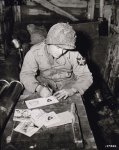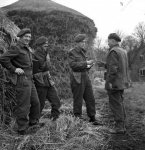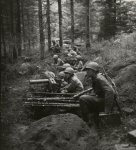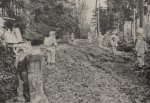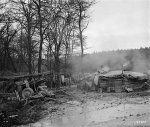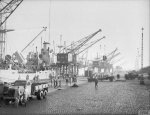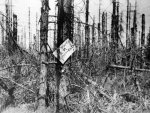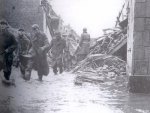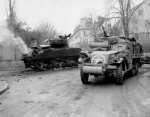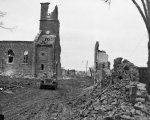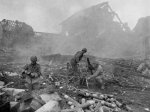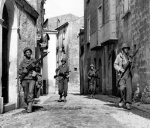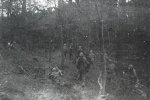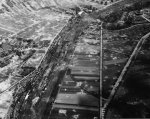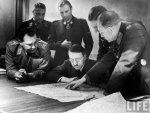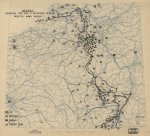November 30, 1944: The Germans begin a major withdrawal from Alsace-Lorraine before the drive of the U.S. Third and Seventh Armies on the southern sector of the Western Front, while to the north Canadian troops are already a mile inside Germany after a regrouping of the forces along the Nijmegen front in Holland.
On the southern end of the front, the French First Corps traps a sizable German force between Mulhouse and Belfort. More than 30 towns are freed, and a steady stream of POWs are taken.
Lt. Gen. George S. Patton's 3rd Army moves forward on a 35-mile front, 26 of those miles inside Germany. Patton's men pass beyond the larger section of the Maginot Line, though they have not yet come up against the Siegfried defenses.
The 95th Division, meeting strong artillery and mortar fire, is only 3+ miles southwest of Saarlautern after a two-mile advance, while the 80th Division makes further gains on the road to Saarbruecken after throwing back a tank-led Nazi counter-attack.
Other units cross the border at a point southwest of Saarlautem, and farther south mechanized cavalry enter the outskirts of Sarre-Union.
Troops and tanks from 1st Army clear the villages of Hurtgen and Kleinhaus and continue northeast to Grosshau, where they fight from house to house, a consistent feature of the battle in this sector. To the north, infantrymen are still working to clear the Germans from the eastern parts of Inden and Lamersdorf.
4th Infantry Division casualties from November 1944:
KIA (killed in action): Officers = 42, Enlisted Men = 390
MIA (missing in action): Officers = 10, Enlisted Men = 245 (Many of these were later listed as KIA)
SWA (seriously wounded in action): Officers = 20, Enlisted Men = 318
LWA (lightly wounded in action): Officers = 133, Enlisted Men = 2,895
Total: Officers = 205, Enlisted Men = 3,848 (Only the month of June had more casualties)
Prisoners Captured: 1,757
Over Germany, the US 8th Air Force attacks Bohlen with 68 bombers, Zeitz with 132 bombers, Merseburg with 417 bombers, Hamburg and Neunkirchen with 284 bombers, Lutzkendorf with 169 bombers, and targets of opportunity with 149 bombers. US 15th Air Force attacks Munich and Innsbruck. RAF Bomber Command sends 60 aircraft to attack Bottrop during the day (escorted by Fighter Command), 60 aircraft to attack Osterfeld during the day (also escorted by Fighter Command), 9 aircraft to attack Duisburg during the day, 576 aircraft to attack Duisburg overnight, and 53 aircraft to attack Hamburg overnight. After the Luftwaffe loses nine more fighters attacking Allied bombers, and angry Goering insists Luftwaffe fighter pilots will no longer be allowed to take parachutes with them when attacking Allied bombers (in order to stiffen their fighting resolve).
On the eastern front, the 53rd Army of 2nd Ukrainian Front captures Eger and pushes toward Miskolc.
In Italy, the British 8th Army attacks toward Casa Bettini and captures Albereto. German forces counterattack British 13th Corps of US 5th Army and capture Casa Nuovo. US 12th Air Force aircraft attack transportation lines and other targets throughout northern Italy.
Pictured: Pvt Walter Prsybyla of B Btry, 37th Field Artillery Regt, US 2nd Inf Div writing Christmas cards for friends and family from an artillery ammunition storehouse, Heckhalenfeld, Germany, November 30, 1944.; Hurtgen Forest Situation Map, late November 1944; Presentation of the Military Medal to Company Sergeant-Major Jim Smith of "D" Company, The South Saskatchewan Regiment, Mook, Netherlands, November 30,1944.; Soldiers of the US 399th Infantry Regiment, 85th Infantry Division occupy a fighting position in Italy in late November, 1944. In the foreground is a water cooled 30 cal. machine gun. They are bunched too close together for actual combat and in all probability have staged this shot for the photographer.
